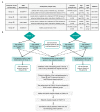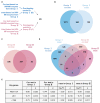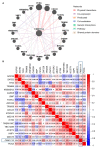FAM111A Is a Novel Molecular Marker for Oocyte Aging
- PMID: 35203468
- PMCID: PMC8869572
- DOI: 10.3390/biomedicines10020257
FAM111A Is a Novel Molecular Marker for Oocyte Aging
Abstract
Aging is the main cause of decline in oocyte quality, which can further trigger the failure of assisted reproductive technology (ART). Exploring age-related genes in oocytes is an important way to investigate the molecular mechanisms involved in oocyte aging. To provide novel insight into this field, we performed a pooled analysis of publicly available datasets, using the overlapping results of two statistical methods on two Gene Expression Omnibus (GEO) datasets. The methods utilized in the current study mainly include Spearman rank correlation, the Wilcoxon signed-rank test, t-tests, Venn diagrams, Gene Ontology (GO), Protein-Protein Interaction (PPI), Gene Set Enrichment Analysis (GSEA), Gene Set Variation Analysis (GSVA), and receiver operating characteristic (ROC) curve analysis. We identified hundreds of age-related genes across different gene expression datasets of in vitro maturation-metaphase II (IVM-MII) oocytes. Age-related genes in IVM-MII oocytes were involved in the biological processes of cellular metabolism, DNA replication, and histone modifications. Among these age-related genes, FAM111A expression presented a robust correlation with age, seen in the results of different statistical methods and different datasets. FAM111A is associated with the processes of chromosome segregation and cell cycle regulation. Thus, this enzyme is potentially an interesting novel marker for the aging of oocytes, and warrants further mechanistic study.
Keywords: DNA replication; FAM111A; WNT signaling pathway; cell cycle; cellular metabolism; histone modifications; oocyte aging.
Conflict of interest statement
The authors declare no conflict of interest.
Figures






Similar articles
-
Differing molecular response of young and advanced maternal age human oocytes to IVM.Hum Reprod. 2017 Nov 1;32(11):2199-2208. doi: 10.1093/humrep/dex284. Hum Reprod. 2017. PMID: 29025019 Free PMC article.
-
Single human oocyte transcriptome analysis reveals distinct maturation stage-dependent pathways impacted by age.Aging Cell. 2021 May;20(5):e13360. doi: 10.1111/acel.13360. Epub 2021 Apr 28. Aging Cell. 2021. PMID: 33908703 Free PMC article.
-
Postovulatory aging affects dynamics of mRNA, expression and localization of maternal effect proteins, spindle integrity and pericentromeric proteins in mouse oocytes.Hum Reprod. 2016 Jan;31(1):133-49. doi: 10.1093/humrep/dev279. Epub 2015 Nov 17. Hum Reprod. 2016. PMID: 26577303 Free PMC article.
-
Transcriptomic profiles reveal the characteristics of oocytes and cumulus cells at GV, MI, and MII in follicles before ovulation.J Ovarian Res. 2023 Nov 22;16(1):225. doi: 10.1186/s13048-023-01291-2. J Ovarian Res. 2023. PMID: 37993893 Free PMC article. Review.
-
Oocyte maturation. Basic and clinical aspects of in vitro maturation (IVM) with special emphasis of the role of FF-MAS.Dan Med Bull. 2008 Feb;55(1):1-16. Dan Med Bull. 2008. PMID: 18321442 Review.
Cited by
-
Alteration in expression and subcellular localization of the androgen receptor- regulated FAM111A protease is associated with emergence of castration resistant prostate cancer.Neoplasia. 2025 Aug;66:101181. doi: 10.1016/j.neo.2025.101181. Epub 2025 May 29. Neoplasia. 2025. PMID: 40446667 Free PMC article.
-
Nicotinamide mononucleotide biosynthesis and the F-actin cytoskeleton regulate spindle assembly and oocyte maturation quality in post-ovulatory aged porcine oocytes.Cell Commun Signal. 2025 Apr 17;23(1):186. doi: 10.1186/s12964-025-02200-4. Cell Commun Signal. 2025. PMID: 40247324 Free PMC article.
References
LinkOut - more resources
Full Text Sources

